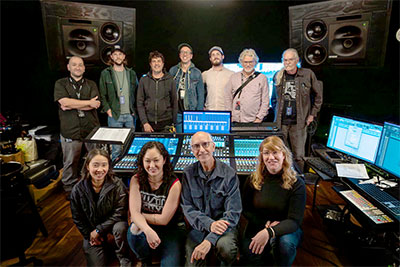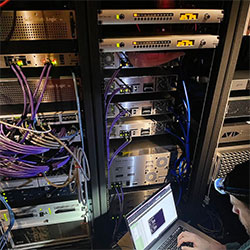A new Solid State Logic System T audio platform is the first to be installed in the audio control room at the 2,750-capacity The Moody Theater – the permanent home of Austin City Limits Live – in 22 years.
The venue hosts around 100 shows a year, 20 of which are captured for broadcast on. Those performances are edited down to 13 one-hour episodes, with some shows spotlighting a single artist and others featuring two.
‘This is a major step for us – it’s going to put us in the 21st century, as well as up our audio game quite a bit,’ says Audio Supervisor Randall Reynolds of the longest-running music show in the history of US television.
 In readiness for the broadcast on PBS stations across the US in autumn 2023, the system comprises a 48-fader S500m console and dual TE1 Tempest Engines with a variety of Network I/O interfaces providing microphone preamps, multi-format connectivity and AD/DA conversion. ‘One of the selling points for us during the demo was the mic preamps; these are the best that there are,’ Reynolds says. ‘We’re super stoked about this desk.’
In readiness for the broadcast on PBS stations across the US in autumn 2023, the system comprises a 48-fader S500m console and dual TE1 Tempest Engines with a variety of Network I/O interfaces providing microphone preamps, multi-format connectivity and AD/DA conversion. ‘One of the selling points for us during the demo was the mic preamps; these are the best that there are,’ Reynolds says. ‘We’re super stoked about this desk.’
The first performance recorded through the S500, a show by Los Angeles-based electro-pop band Muna, was tracked via the production’s transformer splitter and exclusively through System T’s microphone preamps. If permitted by the artist, ACL will simultaneously generate a live stream of the performance through the console. The audio control room also takes a stereo mix from the artist’s front-of-house engineer.
This provided the first opportunity to hear the System T in action for ACL Audio Director David Hough, who has mixed almost every broadcast since the pilot episode featuring Willie Nelson in 1974. ‘When Sachiko [Robertson, Audio Recording, ACL] put up her mix, compared to the mix that was being fed to us from front-of-house, I liked hers better. It was just wonderful,’ Hough says.
The show’s workflow involves two operators at the console during recording, one mixing the live stream plus a feed to the show’s director and one controlling a redundant 128-track Avid Pro Tools systems and monitoring the gains to the DAWs. A typical show uses around 100 channels, including talkback, but a large band, especially one featuring multi-instrumentalists, can require many more.
The show’s previous console operated in split monitor mode, with ‘tape’ returns coming back into the left-hand input channels. ‘System T can be configured to work like an inline console, it can easily switch the monitor between what’s going to “tape” and what’s coming back,’ Hough says. ‘So now we only have to label channels once, rather than twice. That’s one feature that I was delighted to find out about.’
Artists such as Lyle Lovett and Steve Miller have also independently commissioned the ACL audio team to record their concerts at the theatre. ‘That was another one of the selling points of this console,’ Reynolds says. ‘I think that more of these one-offs will happen once people see that we’re running an SSL console in here. We’re going to bring more clients in than we currently do, especially for the high-end recordings that they could get in the process.’
 The standard PBS deliverable for all ACL shows is a 5.1 mix, but Hough is looking forward to being able to use System T’s native 7.1.4 immersive audio production toolkit. He says that when Chuck Ainlay mixed Lyle Lovett’s ACL Season 48 performance for 5.1 broadcast, he also sent him the crowd microphone tracks so that he could create a Dolby Atmos mix, just to evaluate the potential of the show’s technical setup. ‘His response was that, with the eight crowd mics that I had installed out there, he felt like he was standing in the room.’
The standard PBS deliverable for all ACL shows is a 5.1 mix, but Hough is looking forward to being able to use System T’s native 7.1.4 immersive audio production toolkit. He says that when Chuck Ainlay mixed Lyle Lovett’s ACL Season 48 performance for 5.1 broadcast, he also sent him the crowd microphone tracks so that he could create a Dolby Atmos mix, just to evaluate the potential of the show’s technical setup. ‘His response was that, with the eight crowd mics that I had installed out there, he felt like he was standing in the room.’
Having relied for years on the dynamic automation capabilities of the previous console, that was a must-have feature on any replacement desk: ‘That’s something that’s really important to our post production, and something that the System T offered that other consoles did not,’ Reynolds says.
Hough has been using outboard stereo reverbs since the start of the show, he says, but now intends to use System T’s onboard processing once he begins mixing performances for the coming season.
‘For a mix that I have coming up, the lead singer has asked for a nice little slap effect on a vocal. I intend to use SSL’s onboard processing and with SSL’s Dynamic Automation System software, I’ll be able to recall all of those moves and then send her a reference mix. There was a time when approvals would be done in-person at the console, but now we’re relying on emails to do all this.’
A performance by War on Drugs during Season 48 helped persuade Reynolds that an SSL console was the way forward. ‘The band was running SSL Live consoles at front-of-house and at monitors,’ Reynolds says. ‘I felt that the sound quality of that show, from house mix all the way to broadcast, was superb. Seeing those consoles doing their work was really attractive to me and pushed us into a System T demo.
‘I spoke to every single member of our team, both temps and full-time, a lot of whom have been on the team for more than ten years. And unanimously, when it came time to decide how we were going to go forward, they chose System T. Everyone on the team feels that this is the right solution.’
Key Code Media, guided by Senior Solutions Architect Andrew Twenter, installed the production’s first Dante AoIP network, upgraded the DAWs and integrated the new System T into the control room infrastructure. Additionally, Twenter was part of the console purchase decision-making.
‘Andrew had operated SSL boards prior and was very interested in continuing to work with the brand. He also hired amazing people to come in, do all the wiring and get all the I/O where it needed to go,’ Reynolds says. ‘I was happy to have Key Code as an active participant.’
Twenter and Key Code Media specified two SSL Network I/O SB 32.24’s and four SB i16 Stageboxes units for stage mic inputs, an A16.D16 providing AES and Line level Dante conversion, plus four Madi-Bridges and four Madi Opti-Coax converters. Together, the devices provide analogue mic/line patching to the AD converters, a pair of redundant (Primary/Secondary) Dante patches and four lanes of Madi over coax as well as fibre, totalling 496 channels of 96kHz audio.
More: www.solidstatelogic.com















